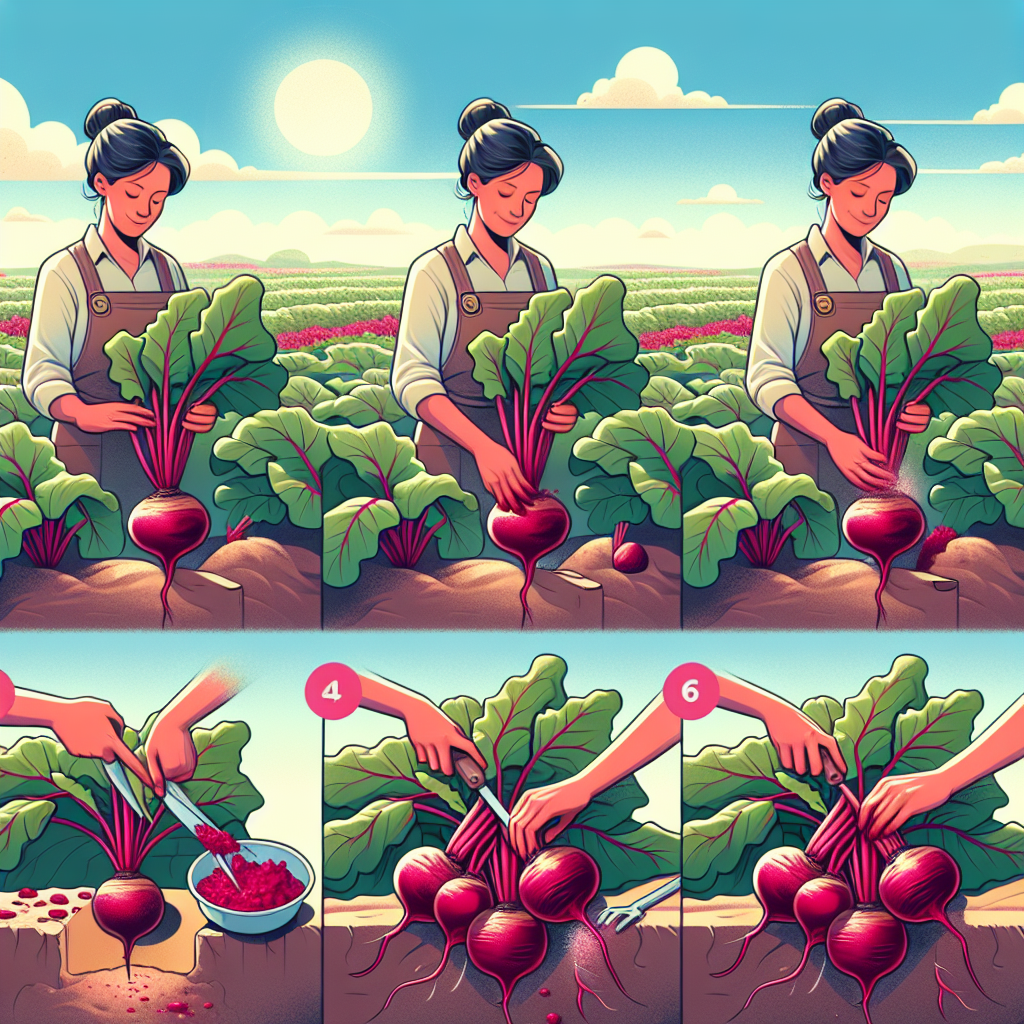
How to harvest beets
How to Grow Beets: A Preliminary Guide
Growing beets can be a rewarding experience for both novice and experienced gardeners. Before diving into the specific steps of harvesting beets, it’s essential to understand the lifecycle of this root vegetable. This article will discuss how to successfully cultivate beets, preparing you for the eventual harvest.
Choosing the Right Beet Variety
There are several varieties of beets, each with distinct characteristics and flavors. Some popular options include:
- Detroit Dark Red: Known for its sweet flavor and vibrant color.
- Golden Beet: A milder-tasting option with a yellow interior.
- Chioggia Beet: Recognized for its unique candy-striped appearance.
Preparing the Soil
Before planting beets, it's crucial to prepare the soil properly. Beets thrive in well-draining, loamy soil that is rich in organic matter. Follow these steps to prepare your garden bed:
- Clear the area of weeds, rocks, and debris.
- Test the soil pH, aiming for a range of 6.0 to 7.5.
- Add compost or well-rotted manure to enhance fertility.
- Till the soil to a depth of at least 12 inches.
Planting Beets
The best time to plant beets is in early spring or late summer. You can directly sow seeds into the garden. Here’s how:
- Make rows about 12 inches apart, and plant seeds 1 inch apart within the rows.
- Cover seeds with approximately 1 inch of soil.
- Water the area thoroughly after planting.
Growing Beets: Care and Maintenance
Once your beets are planted, it’s important to care for them during their growth phase. Consistent moisture and proper care will lead to a successful cropping.
Watering and Fertilizing
Beets need ample water to grow well. Aim for about 1 inch of water per week. Here are some additional care tips:
- Check the soil moisture regularly and adjust watering when necessary.
- Fertilize with a balanced organic fertilizer about three weeks after planting.
- Avoid high-nitrogen fertilizers, as they can encourage leafy growth at the expense of root development.
Pest and Disease Management
Beets can be affected by various pests and diseases. Monitoring your plants can help you tackle problems early:
- Aphids: Spray with insecticidal soap or blast them off with water.
- Leaf miners: Use row covers to protect young plants.
- Powdery mildew: Ensure ample spacing between plants for good air circulation, and refrain from overhead watering.
The Right Time to Harvest Beets
Knowing when to harvest your beets is essential for obtaining the best flavor and texture. The timing varies depending on the variety and growing conditions. Beets are typically ready to harvest when:
- The roots have reached 1.5 to 3 inches in diameter.
- The greens (tops) have grown to about 4 to 6 inches tall.
- You can gently pull up a beet to check the size.
Signs That Beets Are Ready for Harvesting
Here are some specific indicators that can help you determine if your beets are ready:
- Color change: Look for a deep, rich color as the beet matures.
- Firmness: The roots should feel firm to the touch.
- Leaves: The leaves start to fade or lose vibrancy.
How to Harvest Beets: Step by Step Guide
When you’re ready to gather your bounty, follow this straightforward guide on how to harvest beets. Proper techniques will help you maintain the quality of your freshly harvested vegetables.
Tools You Will Need
Gather the following tools before beginning your harvest:
- Garden fork or spade
- Gloves (optional)
- Bucket or basket for collecting
Harvesting Techniques
To ensure a successful harvest and prevent damage to the roots, follow these guidelines:
- Start by loosening the soil around the base of the beet using a garden fork. This will help to prevent breakage.
- Grasp the beet tops firmly but gently and pull them upwards. If they resist, use the garden fork to further loosen the soil.
- Check the root for any signs of damage or rot. Fresh beets should have a smooth surface without blemishes.
- Collect your harvest in a bucket or basket and set aside while you continue harvesting.
Clean and Store Your Beets
After harvesting, it’s essential to clean and store your beets properly to extend their freshness. Follow these steps:
- Gently rinse the beets under cool water to remove dirt.
- Trim the greens, leaving about 1 inch of the stems attached to prevent bleeding.
- Do not wash them until you're ready to use them; excess moisture can lead to rot.
Storing Beets for Long-Term Use
To enjoy your beets long after the harvest, proper storage is key. Here are some tips on securing their longevity:
- Refrigeration: Store fresh beets in a plastic bag in the vegetable crisper. They can last up to a few weeks.
- Canning: Preserve your beets by canning. This method can extend their shelf life for a year or more.
- Freezing: Cook and peel beets before freezing. They can last 8-12 months in the freezer.
Creative Uses for Your Harvested Beets
Once you've harvested and stored your beets, it’s time to think about how to enjoy your delicious vegetables. Here are some ideas:
- Roast them: Roasting enhances their sweetness.
- Add to salads: Fresh beets add color, flavor, and nutrition.
- Make beet juice: Enjoy the health benefits of fresh beet juice.
Tips for Future Harvests
To continually improve your beet-harvesting skills, consider the following tips:
- Keep a gardening journal to track your planting and harvesting dates.
- Experiment with different beet varieties to find your favorite.
- Stay informed about local pests and diseases in your area.
Conclusion
How to harvest beets successfully requires knowledge of the growing process, careful timing, and proper techniques. With these insights, you can enjoy a bountiful harvest of this nutritious root vegetable.
So roll up your sleeves, get your hands in the soil, and start your beet-growing journey today!
```By Guest, Published on October 18th, 2024